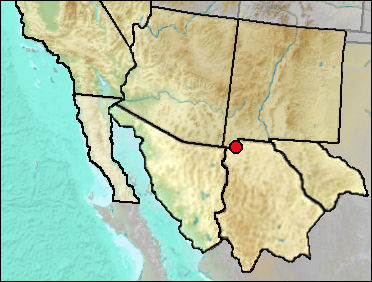 Age. Mid Wisconsin, Late Wisconsin, and
Holocene. 14C dates range from 13,130 ± 180 to 21,210 ± 320 for the deposits
considered by Harris (1989) and are treated here as Late Wisconsin. In the series
considered by Harris in 1987, dates ranged from 26,150 ± 1,450 to 35,890 ± 2,640 BP
among finite dates; these are considered here to be Mid Wisconsin in age. Emslie (1987)
gave a date on a condor coracoid from miner's spoil as 13,030 ± 180 (AA-1492). A
number of elements were recovered from material processed by guano miners; some may be
placed to their source by color or remnants of matrix; others are unassignable; two
taxa otherwise unrepresented are listed under Mid Wisconsin with the additional
statement that they might be Late Wisconsin.
Age. Mid Wisconsin, Late Wisconsin, and
Holocene. 14C dates range from 13,130 ± 180 to 21,210 ± 320 for the deposits
considered by Harris (1989) and are treated here as Late Wisconsin. In the series
considered by Harris in 1987, dates ranged from 26,150 ± 1,450 to 35,890 ± 2,640 BP
among finite dates; these are considered here to be Mid Wisconsin in age. Emslie (1987)
gave a date on a condor coracoid from miner's spoil as 13,030 ± 180 (AA-1492). A
number of elements were recovered from material processed by guano miners; some may be
placed to their source by color or remnants of matrix; others are unassignable; two
taxa otherwise unrepresented are listed under Mid Wisconsin with the additional
statement that they might be Late Wisconsin.
General Description. A large chamber in U-Bar Limestone in an outlier of the Alamo Hueco Mountains.
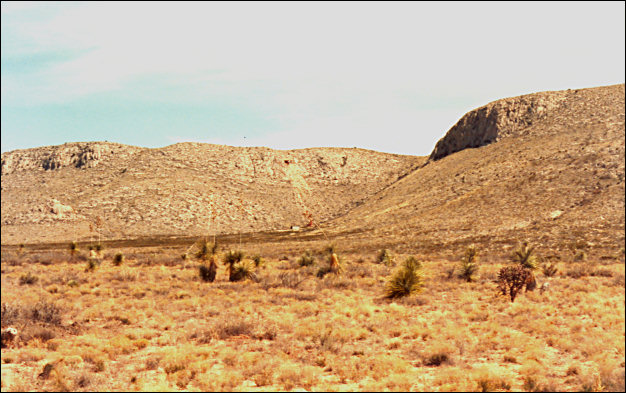 Discussion. Originally, specimens stored at UTEP were considered to be
on long-term loan from the Museum of New Mexico, since U-Bar Cave is state land (except
for surface rights, which are BLM). However, apparently as of May 1990, the BLM has
taken over both archaeological and paleontological control and the U-Bar material is
now considered as having the same status as other BLM material for which UTEP serves as
repository.
Discussion. Originally, specimens stored at UTEP were considered to be
on long-term loan from the Museum of New Mexico, since U-Bar Cave is state land (except
for surface rights, which are BLM). However, apparently as of May 1990, the BLM has
taken over both archaeological and paleontological control and the U-Bar material is
now considered as having the same status as other BLM material for which UTEP serves as
repository.
The historic opening to the cave was small (greatest dimensions according to Lambert and Ambler 1965 were 8 ft wide by 4.5 ft tall). With commencement of mining activities, the entrance was greatly enlarged (Fig. 3).
Fig. 1. U-Bar Cave. The entrance to the cave can be seen in the center near the crest of the mountain. The light area beneath it is spoil and disturbance from mining. Mining equipment and a small building connected with the guano mining is barely visible at the base of the slope. Photograph by A. H. Harris, March 1984.
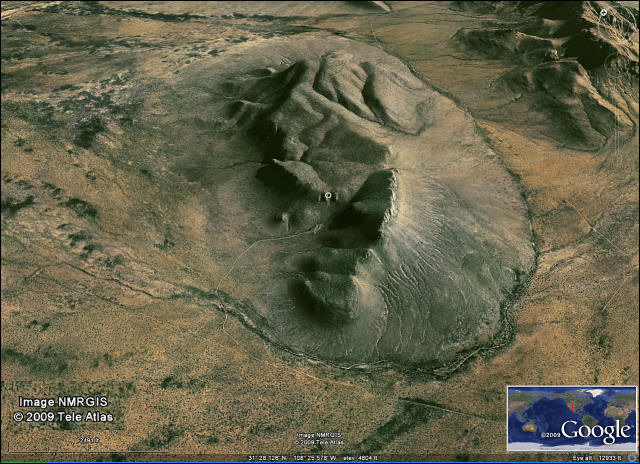
Fig. 2. The setting of U-Bar Cave (white circle). Image from Google Earth.
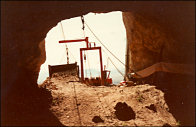 The site originally was an
archaeological site designated as LA 5689 (Lambert and Ambler 1961). During the
archaeological excavations, Pleistocene fossils were recovered and sent to the U.S.
National Museum for identification (Johnson 1961). At a later date, a guano mining
permit was granted by the state, mining equipment was installed, and mining commenced.
When the state realized that a mining permit had been issued for a known archaeological
and paleontological site, a compromise was considered to allow mining to continue while
establishing a degree of monitoring to prevent serious loss of scientific
information.
The site originally was an
archaeological site designated as LA 5689 (Lambert and Ambler 1961). During the
archaeological excavations, Pleistocene fossils were recovered and sent to the U.S.
National Museum for identification (Johnson 1961). At a later date, a guano mining
permit was granted by the state, mining equipment was installed, and mining commenced.
When the state realized that a mining permit had been issued for a known archaeological
and paleontological site, a compromise was considered to allow mining to continue while
establishing a degree of monitoring to prevent serious loss of scientific
information.
Fig. 3. View of the enlarged entrance from within, with mining equipment in place.
The compromise included the presence of a monitor on-site during mining operations (this usually was Harris) with the ability to salvage scientifically important specimens and the authority to limit mining to areas of the cave deemed of minimal scientific value. A number of trips were made during non-mining times to clear areas for later exploitation.
Many fossils were recovered from spoil resulting from miners processing guano by screening at the base of the mountain. This was especially the case at the beginning of the monitoring activities where there was considerable material remaining from earlier mining, but some material was recovered from spoil throughout the period.
For the most part, it's clear which fossils are mid Wisconsin and which are late Wisconsin. Generally, mid-Wisconsin matrix is distinctly red in color whereas most later deposits are tan to whitish. It is believed that a large portion of the mid-Wisconsin matrix is decomposed bat guano (a maternity colony of Brazilian Free-tailed Bats was active for several years during the mining activity before apparently abandoning the site).
The mid Wisconsin and late Wisconsin faunas are listed separately.
The late Wisconsin deposits are more finely dated than the earlier, mid-Wisconsin sediments. Table 1 (adapted from Harris 1989) gives the dates for Area B, which consisted of several 1-m2 grids (H-230-1 to -3, H-231-1 to -3, and H-232-1 to -3) near the eastern wall close to the present entrance. Since this area is well dated, the report of faunal remains are arranged by approximate age, as seen in Table 2. (A few records are from outside Area B but dated as shown.) In the 1989 publication of Harris, Dry Cave faunal remains occurring in the same time spans also were noted, allowing comparison of contemporaneous faunas separated by nearly the entire width of New Mexico. In the present presentation of faunas, some earlier identifications that now seem overly optimistic have been withdrawn, while others have been withdrawn as not clearly present in the time span indicated.
Fauna.
Amphibia
Ambystoma mavortium—Barred Tiger Salamander (Harris 1987)
Scaphiopus/Spea—Spadefoot Toads (Harris 1987)
Anaxyrus—True Toads (Harris 1987)
Incilius alvarius—Sonoran Desert Toad (UTEP)
Chelonia
Terrapene—Box Turtle (UTEP: ?)
Gopherus—Gopherus Tortoises (UTEP: cf.)
Reptilia
Crotaphytus collaris—Eastern Collared Lizard (Harris 1987)
Heloderma suspectum—Gila Monster (Harris 1993c)
Phrynosoma cornutum—Texas Horned Lizard (Harris 1987)
Phrynosoma hernandesi—Mountain Short-horned Lizard (Harris 1987)
Phrynosoma modestum—Round-tailed Horned Lizard (Harris 1993c)
Sceloporus (large)—Large Spiny Lizard (Harris 1987)
Sceloporus (small)—Small Spiny Lizard (Harris 1987)
Aspidoscelis (large)—Large Whiptail Lizard (Harris 1987)
Pituophis—Gopher Snakes (Harris 1987: ?)
Salvadora—Patch-nose Snakes (Harris 1993c: cf.)
Crotalus—Rattlesnakes (Harris 1987)
Aves
†Anabernicula—Sheldgoose (Harris 1987: cf.)
Anas cyanoptera—Cinnamon Teal (Harris 1993c: ?; may be Late Wisconsin)
Anas platyrhynchos—Mallard (Harris 1987: cf.)
Centrocercus urophasianus—Greater Sage-grouse (UTEP)
Colinus virginianus—Northern Bobwhite (Harris 1987: ? gen. et)
Breagyps clarkii—Clark's Condor (Harris 1993c: may be Late Wisconsin)
Cathartes aura—Turkey Vulture (Harris 1987: cf. gen. et)
Coragyps atratus—Black Vulture (Harris 1993c: cf.)
†Coragyps occidentalis—Western Vulture (Harris 1993c)
Aquila chrysaetos—Golden Eagle (Harris 1987)
Falco sparverius—American Kestrel (Harris 1987: cf. gen. et)
Zenaida macroura—Mourning Dove (Harris 1987)
†Geococcyx californianus conklingi—Conkling's Roadrunner (Harris 1987)
Strix occidentalis—Spotted Owl (Harris 1987: cf.)
Colaptes auratus—Northern Flicker (Harris 1987)
Salpinctes obsoletus—Rock Wren (Harris 1987: cf. gen. et sp.)
Mammalia
†Nothrotheriops shastensis—Shasta Ground Sloth (Harris 1987)
Cynomys gunnisoni —Gunnison's Prairie Dog (Goodwin 1995; UTEP)
Ictidomys/Xerospermophilus—Ictidomys/Xerospermophilus Ground Squirrel (Harris
1987)
Marmota flaviventris—Yellow-bellied Marmot (Harris 1987)
Otospermophilus variegatus—Rock Squirrel (Harris 1987)
Tamias—Chipmunk (UTEP)
Chaetodipus—Spiny Pocket Mice (Harris 1987)
Dipodomys (small)—Merriam's or Ord's Kangaroo Rat (UTEP)
Dipodomys spectabilis—Banner-tailed Kangaroo Rat (Harris 1993c)
Perognathus flavus—Silky Pocket Mouse (Harris 1987: cf.)
Thomomys bottae—Botta's Pocket Gopher (Harris 1987)
Lemmiscus curtatus—Sagebrush Vole (Harris 1987)
Microtus mogollonensis—Mogollon Vole (Harris 1987)
Microtus pennsylvanicus—Meadow Vole (Harris 1987)
Neotoma albigula—White-throated Woodrat (Harris 1987)
Neotoma cinerea—Bushy-tailed Woodrat (Harris 1987)
Neotoma findleyi—Findley's Woodrat (Harris 1987)
Neotoma mexicana—Mexican Woodrat (Harris 1987)
Neotoma stephensi—Stephen's Woodrat (Harris 1987)
Peromyscus boylii—Brush Mouse (UTEP: ?)
Peromyscus nasutus—Rock Mouse (Harris 1987)
Peromyscus truei—Pinyon Mouse (Harris 1987)
Reithrodontomys megalotis—Western Harvest Mouse (Harris 1987: cf.)
Sigmodon—Cotton Rats (Harris 1987)
Erethizon dorsata—American Porcupine (UTEP)
†Aztlanolagus agilis—Aztlán Rabbit (Harris 1987)
Lepus californicus—Black-tailed Jackrabbit (UTEP)
Sylvilagus audubonii—Desert Cottontail (UTEP)
Sylvilagus nuttallii—Mountain Cottontail (Harris 1987)
†Notiosorex dalquesti—Dalquest's Shrew (Carraway 2010)
†Notiosorex harrisi—Harris' Shrew (Carraway 2010)
Sorex merriami—Merriam's Shrew (Harris 1987)
Sorex monticola—Montane Shrew (Harris 1993c: cf.)
Sorex preblei—Preble's Shrew (Harris and Carraway 1993)
Tadarida brasiliensis—Brazilian Free-tailed Bat (Harris 1987)
†Desmodus stocki—Stock's Vampire Bat (Harris 1987)
Antrozous pallidus—Pallid Bat (Harris 1987)
Corynorhinus townsendii—Townsend's Big-eared Bat (Harris 1993c)
Eptesicus fuscus—Big Brown Bat (Harris 1987)
Myotis ciliolabrum—Western Small-footed Myotis(Harris 1993c)
Myotis lucifugus—Little Brown Bat (Harris 1993c)
Myotis velifer—Cave Myotis (Harris 1987)
Lynx rufus—Bobcat (Harris 1987)
Canis (large)—Wolf (UTEP)
Urocyon cinereoargenteus—Gray Fox (Harris 1987)
†Arctodus simus—Giant Short-faced Bear (Harris 1987)
Ursus americanus—Black Bear (Harris 1987: cf.)
Taxidea taxus—American Badger (Harris 1987)
Mephitis mephitis—Striped Skunk (Harris 1987)
Spilogale gracilis/putorius—Spotted Skunk (Harris 1987)
Bassariscus astutus—Ringtail (Harris 1993c)
†Equus conversidens—Mexican Horse (Harris 1987)
†Equus scotti—Scott's Horse (Harris, 1989)
†Equus occidentalis—Western Horse (Harris 1987: cf.)
†Camelops—Camel (Harris 1987: cf.; UTEP)
Odocoileus—Deer (Harris 1993c)
†Navahoceros—Mountain Deer (Harris 1987: ?)
Antilocapra americana—Pronghorn (UTEP)
†Capromeryx—Miniature Pronghorns (Harris 1987)
†Stockoceros conklingi—Conkling's Pronghorn (Harris 1987)
Bison—Bison (Harris 1993c: possibly Late Wisconsin)
†Euceratherium collinum—Shrub-ox (UTEP)
†Oreamnos harringtoni—Harrington's Mountain Goat (Harris 1993c)
Withdrawn.
Urosaurus ornatus—Tree Lizard (Harris 1987: cf. gen. et)
Xanthocephalus xanthocephalus—Yellow-headed Blackbird (Harris 1993c: ? gen. et)
Tamias dorsalis—Cliff Chipmunk (Harris 1987: ?)
Peromyscus eremicus—Cactus Mouse (Harris 1987)
Peromyscus maniculatus—Deer Mouse (Harris 1987)
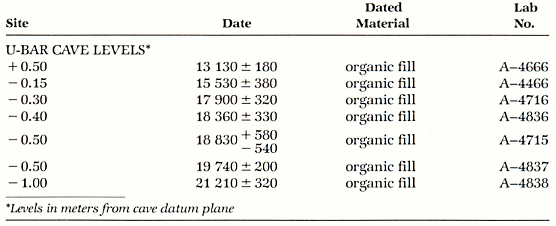
Table 2. Temporal occurrences of taxa in Area B, U-bar Cave, Hidalgo County, New Mexico (adapted in part from Harris (1989); nomenclature up-dated).
| Taxon | 18-20 ka | 15-18 ka | 14-15 ka | 13-14 ka |
| Osteichthyes (Harris 1989) | X | X | ||
| Amphibia | ||||
| Ambystoma mavortium—Barred Tiger Salamander (Harris 1989) | X | X | ||
| Scaphiopus/Spea—Spadefoot Toad (Harris 1989) | X | |||
| Anaxyrus debilis—Green Toad (Harris 1989) | Cf. | |||
| Anaxyrus microscaphus—Arizona Toad (Harris 1989) | ? | |||
| Anaxyrus/Incilius.—True Toads (Harris 1989) | X | X | X | |
| Incilius alvarius—Colorado River Toad (Harris 1989) | X | |||
| Chelonia Turtles (Harris 1989) | X | X | X | X |
| Terrapene ornata—Ornate Box Turtle (Harris 1989) | Cf. | Cf. | ||
| Gopherus—Tortoise (Harris 1989) | Cf. | X | Cf. | |
| Reptilia | ||||
| Crotaphytus collaris—Eastern Collared Lizard (Harris 1989) | X | |||
| Sceloporus—(large) Large Spiny Lizard (Harris 1989) | Cf. | X | ||
| Sceloporus jarrovii—Yarrow's Spiny Lizard (Harris 1989) | Cf. | Cf. | ||
| Phrynosoma cornutum—Texas Horned Lizard (Harris 1989) | Cf. | |||
| Phrynosoma hernandesi—Mountain Short-horned Lizard (Harris 1989) | X | X | Cf. | X |
| Masticophis—Whipsnake (Harris 1989) | X | |||
| Sonora—Ground Snakes (Harris 1989) | ? | |||
| Crotalus—Rattlesnakes (Harris 1989) | X | X | X | X |
| Aves | ||||
| Anas platyrhynchos—Mallard (Harris 1989) | Cf. | |||
| Centrocercus—Sage-Grouses (Harris 1989) | X | X | ||
| Meleagris—Turkey (Harris 1989) | Cf. | Cf. | ||
| Cathartes aura—Turkey Vulture (Harris 1989) | X | |||
| †Coragyps occidentalis—Western Vulture (Harris 1989) | X | |||
| Gymnogyps californianus—California Condor (Harris 1989) | X | |||
| Buteo—Buteo Hawk (Harris 1989) | ? | |||
| Caracara cheriway—Crested Caracara (Harris 1989) | X | X | ||
| Falco sparverius—American Kestrel (Harris 1989) | X | |||
| Fulica americana—American Coot (Harris 1989) | ? | |||
| †Geococcyx californianus conklingi—Conkling's Roadrunner (Harris 1989) | X | X | ||
| Megascops kennicottii—Western Screech-Owl (Harris 1989) | Cf. | Cf. | Cf. | |
| Corvus corax—Common Raven (Harris 1989) | X | |||
| Mammalia | ||||
| †Nothrotheriops shastensis—Shasta Ground Sloth (Harris 1989) | X | X | X | |
| Cynomys—Prairie Dogs (Harris 1989) | X | X | X | X |
| Ictidomys/Xerospermophilus—Spotted or Thirteen-lined Ground Squirrel (Harris 1989) | X | X | X | |
| Marmota flaviventris—Yellow-bellied Marmot (Harris 1989) | X | |||
| Otospermophilus variegatus—Rock Squirrel (Harris 1989) | X | X | X | |
| Tamias—Chipmunk (Harris 1989) | X | X | X | |
| Xerospermophilus spilosoma—Spotted Ground Squirrel (Harris 1989) | X | X | Cf. | |
| Chaetodipus—Spiny Pocket Mice (Harris 1989) | X | |||
| Dipodomys merriami/ordii—Merriam's or Ord's Kangaroo Rat (Harris 1989) | * | |||
| Dipodomys spectabilis—Banner-tailed Kangaroo Rat (Harris 1989) | Cf. | Cf. | X | Cf. |
| Perognathus—Silky Pocket Mice (Harris 1989) | X | X | X | X |
| Cratogeomys castanops—Yellow-faced Pocket Gopher (Harris 1989) | X | X | X | |
| Thomomys—Thomomys Pocket Gophers (Harris 1989) | X | X | X | X |
| Thomomys bottae—Botta's Pocket Gopher (Harris 1989) | X | Cf. | X | |
| Lemmiscus curtatus—Sagebrush Vole (Harris 1989) | X | X | X | |
| Microtus—Voles (Harris 1989) | X | X | X | X |
| Microtus mogollonensis—Mogollon Vole (Harris 1989) | X | X | X | |
| Microtus pennsylvanicus—Meadow Vole (Harris 1989) | X | |||
| Neotoma albigula—White-throated Woodrat (Harris 1989) | X | X | X | X |
| Neotoma cinerea—Bushy-tailed Woodrat (Harris 1989) | X | X | X | Cf. |
| Neotoma floridana—Eastern Woodrat (Harris 1989) | Cf. | Cf. | Cf. | |
| Neotoma mexicana—Mexican Woodrat (Harris 1989) | X | X | X | X |
| Neotoma stephensi—Stephen's Woodrat (Harris 1989) | X | X | X | X |
| Onychomys leucogaster—Northern Grasshopper Mouse (Harris 1989) | X | |||
| Peromyscus—White-footed Mouse (Harris 1989) | X | X | X | X |
| Peromyscus crinitus—Canyon Mouse (UTEP) | X | |||
| Reithrodontomys—Harvest Mouse (Harris 1989) | X | |||
| Sigmodon—Cotton Rats (Harris 1989) | X | X | ||
| Sigmodon ochrognathus—Yellow-nosed Cotton Rat (Harris 1989) | X | |||
| †Aztlanolagus agilis Aztlán Rabbit (Harris 1989) | X | X | X | X |
| Lepus—Jackrabbits (Harris 1989) | X | X | X | X |
| Lepus californicus—Black-tailed Jackrabbit (Harris 1989) | X | ? | ||
| Sylvilagus audubonii—Desert Cottontail (Harris 1989) | X | X | X | X |
| Sylvilagus nuttallii—Mountain Cottontail (Harris 1989) | X | X | ||
| Notiosorex dalquesti—Dalquest's Shrew (Carraway 2010) | X | X | X | X |
| Notiosorex harrisi—Harris' Shrew (Carraway 2010) | X | |||
| Sorex—Long-tailed Shrews (Harris 1989) | X | X | X | |
| Sorex merriami—Merriam's Shrew (Harris 1989) | Cf. | |||
| Tadarida brasiliensis—Brazilian Free-tailed Bat (Harris 1989) | X | X | X | X |
| Antrozous pallidus—Pallid Bat (Harris 1989) | X | X | X | |
| Corynorhinus—Big-eared Bats (Harris 1989) | X | X | X | X |
| Corynorhinus townsendii—Townsend's Big-eared Bat (Harris 1989) | X | X | ||
| Eptesicus fuscus—Big Brown Bat (Harris 1989) | X | X | ||
| Myotis (smaller)—Smaller Myotis (Harris 1989) | X | X | X | |
| Myotis velifer—Cave Myotis (Harris 1989) | Cf. | X | Cf. | Cf. |
| Lynx rufus—Bobcat (Harris 1989) | X | X | X | X |
| Puma concolor—Mountain Lion (Harris 1989) | X | X | ||
| †Canis dirus—Dire Wolf (Harris 1989) | Cf. | X | ||
| Canis latrans—Coyote (Harris 1989) | X | X | X | |
| Urocyon cinereoargenteus—Gray Fox (Harris 1989) | Cf. | X | ||
| Ursus americanus—Black Bear (Harris 1989) | X | |||
| Mustela frenata—Long-tailed Weasel (Harris 1989) | X | X | ||
| Taxidea taxus—American Badger (Harris 1989) | X | X | ||
| Mephitis mephitis—Striped Skunk (Harris 1989) | X | X | X | X |
| Spilogale gracilis/putorius—Spotted Skunk (Harris 1989) | X | X | ||
| Bassariscus—Ringtail (Harris 1989) | X | |||
| Equus—Horses (Harris 1989) | X | X | X | X |
| †Equus conversidens—Mexican Horse (Harris 1989) | Cf. | X | ||
| †Equus scotti—Scott's Horse (Harris 1989) | Cf. | |||
| Odocoileus—Deer (Harris 1989) | X | X | ||
| Odocoileus virginianus—White-tailed Deer (Harris 1989) | Cf. | |||
| †Stockoceros—Four-horned Pronghorn (Harris 1989) | Cf. | X | X | X |
| †Capromeryx—Miniature Pronghorns (Harris 1989) | X | ? | X | |
| Bison—Bison (Harris 1989) | Cf. | |||
| †Euceratherium collinum—Shrub-ox (Harris 1989) | Cf. | X | X | X |
* Probably intrusive
Amphibia
Ambystoma mavortium—Barred Tiger Salamander (18-22 ka; UTEP)
Reptilia
Bogertophis subocularis—Trans-Pecos Rat Snake (UTEP)
Aves
Meleagris crassipes—Big-foot Turkey (Harris 1993c: Mid/Late Wisconsin)
Accipiter cooperii—Cooper's Hawk (UTEP: 13-15 ka)
Athene cunicularia—Burrowing Owl (Harris 1993c)
Pica hudsonia—Black-billed Magpie (Harris 1993c)
Mammalia
Cynomys gunnisoni—Gunnison's Prairie Dog (Goodwin 1995)
Sigmodon hispidus—Hispid Cotton Rat (Harris 1993c: Late
Wisconsin/Holocene)
Lepus townsendii—White-tailed Jackrabbit (UTEP: cf.)
Navahoceros fricki—Mountain Deer (UTEP)
Antilocapra americana—Pronghorn (Harris 1993c; possibly Holocene)
Stockoceros conklingi—Conkling's Pronghorn (UTEP)
Bison—Bison (UTEP)
Withdrawn
Falco—Falcon (Harris 1989)
Microtus ochrogaster—Prairie Vole (Harris 1993c: ?)
Literature. Carraway 2010; Emslie 1987; Goodwin 1995; Harris 1985a, 1985b, 1987, 1988, 1989, 1990b, 1993c; Harris and Carraway 1993; Johnson 1961; Lambert and Ambler 1961; Russell and Harris 1986.
Last Update: 6 Feb 2013